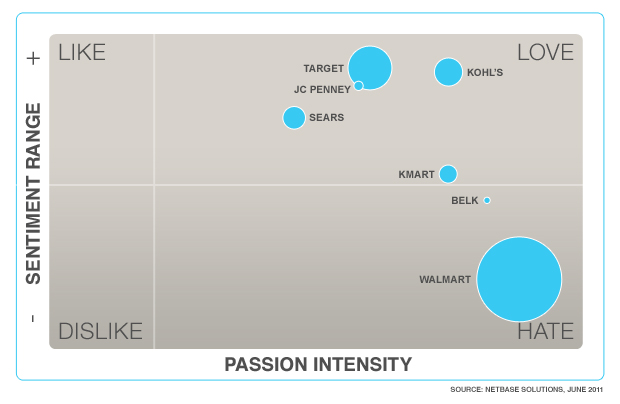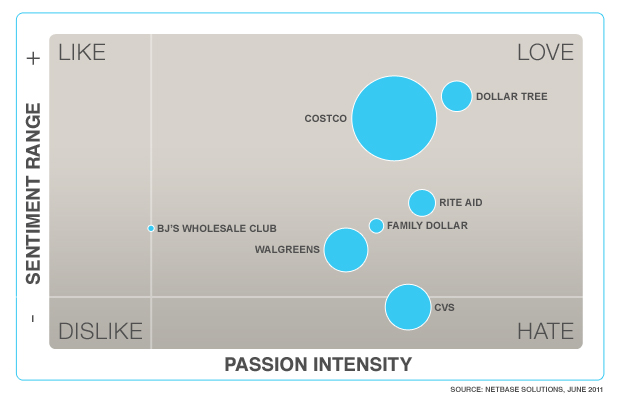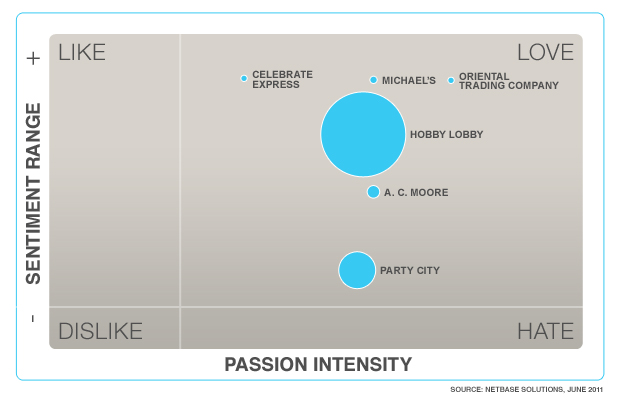Should Brands be Chicken When It Comes to Facebook?
Does sentiment drive openness or does openness drive sentiment?
There is no easy answer to this “chicken or egg” question. But there is no question social media is opening up (a quite public) window on the relationship between top retail brands and their customers. And though it is not necessary for retailers to prioritize openness – say, by defaulting likers to a “Top Posts” Facebook wall – not doing so (or being unable to do so), particularly when key competitors can, says something about a brand and offers clues as to how that brand operates in social space.
Media Logic has just completed a quick analysis of the relationship between brand sentiment/passion and the willingness of brands to prioritize customer posts on an open Facebook wall. We examined brands in three retail sectors – Department stores, Discount and Value stores and Hobby stores.
The accompanying charts generated by Netbase graph brand sentiment along the Y-axis and conversational intensity along the X-axis. The size of the circles is a relative measure of social chat volume. Short story: being in the upper right quadrant is good. Being a big circle in the upper right quadrant is even better. Being in the lower right quadrant is not so good. And being a big circle in the lower right quadrant is something a brand might want to work really hard to counter.
When we overlay wall openness with these circles, what we see is not terribly surprising. In fact, the results may even be a bit circular. “Passionately loved” brands generally default likers to an open wall of “Most Recent” or “Top Posts.” “Passionately hated” brands default likers to a wall of brand-generated posts. While none of the 20 brands measured here prevents users from posting to the wall, disliked and passionately disliked brands generally make visitors dig past the default brand wall to see complaints (or compliments) left by other likers.
This makes perfect sense. Brands that attract a lot of positive user posts no doubt find it easier – emotionally and bureaucratically – to promote those posts.
But maybe we should dig a little deeper. Because, as Media Logic has learned from a year of pretty intense study, the rules and opportunities of social marketing vary sector to sector and brand to brand. Let’s look at each sector and see if we can divine any general rules and uncover best practices.
Department stores
In the Department sector there are only two brands that prioritize fan posts, the medium-sized circle of Kohl’s and the tiny circle of Belk. A quick tour of their respective Facebook efforts shows Kohl’s exists in a special place, with a large enough and positively passionate enough fan base to make their wall all but self-policing. Negative comments are countered voluntarily by fans, with statements like, “If you don’t like Kohl’s, why are you a friend??” Belk has to take a more active role in managing its conversations. But the brand appears willing to make the investment, often answering customer service queries in a few minutes. And the general impression is that this active management is paying off – at least in Belk’s Facebook space – as the brand’s general page zeitgeist is positive, even joyful.
Meanwhile, Walmart carries the dubious distinction of being the most passionately hated brand among the 20 reviewed here. A quick trip to its Facebook page, not surprisingly, shows that Walmart defaults likers to brand posts. If one digs into its “Most Recent” or “Top Posts,” it’s easy to see why. Walmart, the 800-lb gorilla of retail, draws lots of negative posts. But as Media Logic has noted previously, the brand is hardly a passive social player. Over the last year, Walmart has invested heavily, not only in managing its Facebook wall and answering nearly every customer complaint, but also managing a solid, green-focused, Twitter stream. Walmart also seems to actively listen to the organic (and apparently largely negative) social conversation and respond to it through its community outreach programs.
As Walmart has been the fastest growing brand on Facebook for at least the last six months, it will be interesting to see if its active management of that channel can nudge its Netbase sentiment score northward.
Discount and Value stores
Among Discount and Value stores, four brands default likers to open walls, while three default to brand posts. Costco, Dollar Tree and BJ’s, default to the most open of open walls, “Most Recent” posts. Family Dollar defaults to “Top Posts.” Rite Aid, Walgreens and CVS all default to brand posts.
Sadly, the general theme for this sector is “missed opportunity.” There is only one winner here, and it’s a surprise. Perhaps because of its unfortunate poor sentiment and passion index, CVS has, over the last year, taken the most active position relative to its competitors. The Discount and Value brand manages its wall very actively. It also runs regular, well-designed promotions to boost its liker base.
Meanwhile, Dollar Tree, Costco and Rite Aid are squandering enviable positive sentiment and customer passion by letting their walls fill with scams and spam. These brands, along with Family Dollar and Walgreens, should look to CVS (despite that brand’s low Netbase score) as an example. In just over a year, CVS has attracted nearly a half-million likers with its actively managed Social Promotions and Social Stream Marketing effort.
Hobby stores
The Recreation sector, particularly Hobby stores, contains brands that have most benefited from maintaining open Facebook walls. In our group of six, only Party City defaults users to brand posts. It’s low sentiment score may account for the brand’s position here. But a quick review of its “Top Posts” suggests the brand could benefit from opening things up. For almost all Recreation brands, and certainly all Hobby brands, the Facebook wall has become a community forum, a place for likers to show off and share their handiwork. The only thing Hobby brands need to do, it seems, is run regular promotions to attract new likers, engage current fans and conduct a modest amount of policing to keep the spammers at bay.
As Media Logic has written before, a few Specialty Hardlines brands (specifically Bed Bath & Beyond) have seen great social marketing success by picking up cues from the Recreation sector and promoting actively managed open Facebook walls.
Conclusion
While there is yet no clear answer to the “chicken or egg” question that opened this article, top brands, including Kohl’s, CVS and Hobby Lobby, do point to general rules and best practices. And they also point to the value of active social media management.
Whether your brand can run a lightly-policed open wall or needs to default to a brand wall and actively engage negative social sentiment, there really is no longer any excuse for not investing in professional management.
Media Logic is a pioneer in marketing for a social world. We have created a new generation of professional marketing services, driven by active Conversation Management and powered by our social collaboration platform, Zeitgeist & Coffee, designed to help both B2B and consumer brands realize the full potential of social media.
Call us for a chat sometime. We guarantee that it will be worth your while and that we won’t try to hook you … at least not right away.







